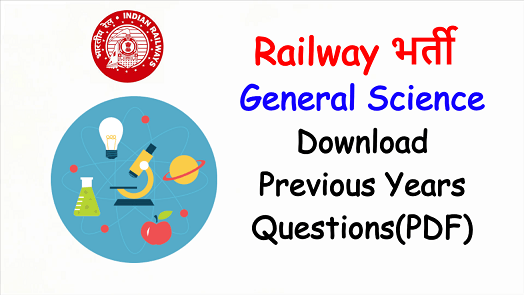Dear Aspirants,
We are providing the most important General Science Previous year Questions for RRB NTPC 2019, RRB Group D 2019, SSC 2019 and all other competitive exams. These questions have very high chances to be asked in RRB NTPC 2019, RRB Group D 2019.
Set-16 General Science Previous Year Questions
Download our GK Gaming Application “GKPK” (30000+) for upcoming RRB NTPC 2019,RRB Group D 2019.
To download “GKPK”,search “GKPK” on PlayStore or just click here.
1.Instrument for measuring rainfall is called –
1. Lucimeter
2. Galactometer
3. Hyetometer
4. Hygrometer
Ans:3
2.Who established the foundations of the quantum theory?
1. Max Planck
2. Mark Nicholas
3. Albert Einstein
4. Alfred Hitchcock
Ans:1
3. If in a motion, the axis of the rotation passes through an object, the motion is called _________.
1. Orbital motion
2. Circulatory motion
3. Spin motion
4. Oscillatory motion
Ans:3
4.What is the angle between centripetal acceleration and tangential acceleration?
1. 90°
2. 45°
3. 0°
4. 180°
Ans:1
5. Rectifiers convert _____.
1. high voltage to low voltage
2. low voltage to high voltage
3. AC to DC
4. DC to AC
Ans:3
6. Name the first Indian who got Nobel Prize in physics.
1. C K Naidu
2. Rangnath Mishra
3. Amartya Sen
4. C V Raman
Ans:4
7.Which physical quantity is measured in ‘siemens’?
1. Electric potential
2. Electrical conductance
3. Magnetic flux
4. Refractive index
Ans:2
8.Who invented Universal Standard Time?
1. Enrico Fermi
2. Adolf Gaston Eugen Fick
3. Sandford Fleming
4. Benoit Fourneyron
Ans:3
9._____________________ states that the total current entering a junction is equal to the total current leaving the junction.
1. Lenz’s Law
2. Hooke’s Law
3. Ohm’s Law
4. Kirchhoff’s First Law
Ans:4
10.Acceleration due to gravity on a planet decreases with ______.
1. decrease in radius of the planet
2. increase in mass of the planet
3. decrease in mass of the body
4. increase in altitude from surface of the planet
Ans:4
11.Instrument for measuring wind velocity is called –
1. Coulombmeter
2. Anemometer
3. Cyanometer
4. Chronometer
Ans:2
12.Who was the first Indian astronaut to travel in space?
1. Rakesh Sharma
2. Ravish Malhotra
3. Kalpana Chawla
4. Sheikh Muszaphar Shukor
Ans:1
13.AV= constant, where A= area of cross-section and V= velocity of fluid. This equation is called _____.
1. Equation of discontinuity
2. Equation of continuity
3. Equation of sustenance
4. Equation of parallelism
Ans:2
14.A body in equilibrium _______.
1. can move with constant acceleration
2. is always at rest
3. can move with constant velocity
4. can move with variable acceleration
Ans:3
15.What is the viscosity of an ideal fluid?
1. Equal to its mass
2. Equal to its weight
3. Zero
4. One
Ans:3
16.A parachute descends slowly whereas a stone dropped from the same height falls rapidly, because –
1. Stone is heavier than parachute
2. Special mechanisms are present in parachute
3. A parachute has a larger surface area and air resistance is more
4. None of the above
Ans:3
17.Shaving mirror is –
1. Convex
2. Concave
3. Plane
4. Parabolic
Ans:2
18.The spoon dropped by an astronaut in a satellite will –
1. Fall to the floor
2. Remain stationary
3. Continue to follow the motion of the satellite
4. Move tangentially away
Ans:3
19.“Curie” is the unit of –
1. Radioactivity
2. Temperature
3. Heat
4. Energy
Ans:1
20.The Source of the sun’s energy, is the process of –
1. Photoelectric emission
2. Nuclear fission
3. Nuclear fusion
4. Thermionic emission
Ans:3

